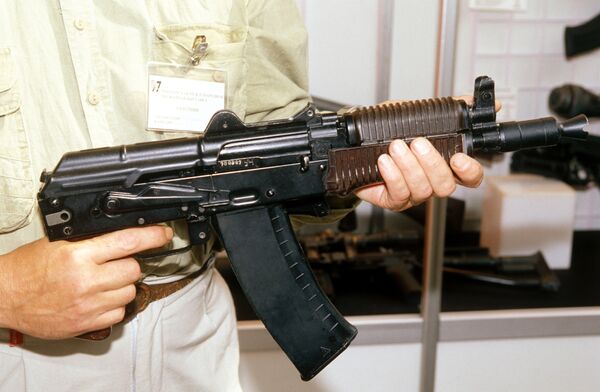MOSCOW. (RIA Novosti military analyst Ilya Kramnik) - On November 10, 2009, Mikhail Kalashnikov, who created what is truly the most well-known weapon in modern history, will celebrate his 90th birthday.
Kalashnikov's assault rifle and the derivatives thereof, which have been manufactured in the tens of millions, have ceased to be merely a weapon. They have also become a symbol of the many local wars of the 20th and 21st centuries.
Small arms are usually objects of greater interest than other types of weaponry and military hardware. This is easily explained - assault rifles, machine guns, pistols and other small arms are the most familiar to the average person, and require neither special training nor the resources of an entire military unit for their use. What is the role of small arms in warfare, and what role will they play in the future?
Despite the increasing importance of artillery, armor and aviation, the infantryman with a small arms weapon is still the force without which the newest forms of military hardware and armaments would be defenseless, and thus irrelevant. And if one takes this into account, the significance of a soldier and his personal weapon is even greater. Without infantry cover and escort, neither tanks nor artillery would be capable of achieving their military objectives, all the more so since wars cannot be won by air and naval forces alone without the ground forces that rely on infantrymen.
Local armed conflicts became predominant after the end of World War II, making small arms even more important. Soldiers with their personal weapons played a much bigger role in the armies of Third World countries, which lacked modern military hardware, than in the armies of developed countries.
At the same time, the role developed countries played in local conflicts was different. As before, operations using "remote" systems such as aviation, the importance of which had greatly increased, and artillery caused the bulk of enemy casualties. In turn, soldiers in modern armies suffered losses from mines, as well as from small arms fire from partisans, insurgents, rebels, fighters, and terrorists (take your pick).
Thankfully, there were no wars between great powers after World War II, therefore it is impossible to say what role small arms would have played in such conflicts. In addition, when one takes into account the military doctrines adopted in the U.S. and U.S.S.R during the Cold War era, particularly in the 1960s and 1970s, it seems obvious that the main casualties would come from weapons of mass destruction, primarily nuclear weapons. Conventional means of destruction would seem insignificant in comparison, and the share of small arms would seem even more negligible.
Nevertheless, all developed countries continued their spirited development of small arms. Why? The reason remained the same - as before, a solider armed with an individual weapon remained the main element of the military machine, supporting the operations for all other units. This was particularly noticeable in local conflicts, where the importance of infantry in routine maneuvers such as sweep-and-clear operations, controlling territory, etc. remained very high.
It is unlikely that the importance of the soldier with his personal weapon will diminish in the foreseeable future. In fact, the opposite is more likely, considering how expensive and scarce modern military hardware is becoming.
What will small arms be like in the foreseeable future? Don't hold your breath for the impending arrival of handheld lasers - the technological problems of these systems are far from being resolved. The main progress in the field of small arms today is in improving existing systems and models, which are becoming more lightweight (because of new materials), and easier to use (because of folding and telescopic stocks, modern sighting options, etc.). Weapons technologies are also improving; for example, systems with balanced action are being developed (including the AK-107 and AK-108 assault rifles, both based on the AK-47), which have much better shots grouping while maintaining the reliability and ease of maintenance of conventional models.
The opinions expressed in this article are the author's and do not necessarily represent those of RIA Novosti.

